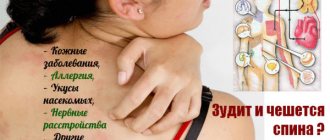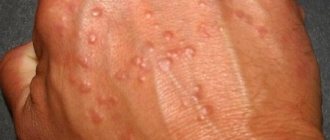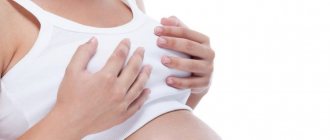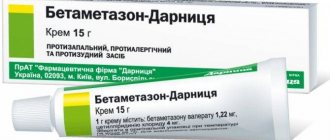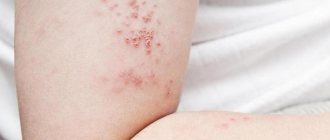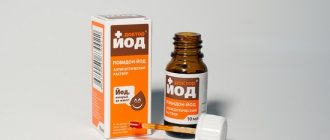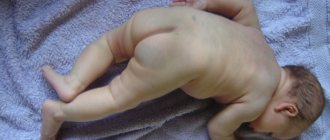Types of watery blisters
A blister is a cavity that is formed as a result of acute inflammation of the skin. The entire space is filled with a clear serous fluid (serum), sometimes mixed with blood.
Depending on the root cause, bubbles appear singly or in groups. They can rash locally in a certain area and generalized - from the head to the feet.
Blisters with fluid on any part of the body are distinguished by type:
- vesicles - small formations up to 5 mm;
- bullae - single- or multi-cavity large blisters measuring 10 mm or more;
- pustules are cavities with purulent contents.
The rash is small and round in shape; large bullae may be asymmetrical.
Causes
Skin rashes in the form of blisters with liquid appear in adults as a reaction to the influence of negative factors from within the body or from the external environment. The cause may be rubbing with clothing, kitchen utensils, or garden tools; thermal and chemical burns. But the most serious group is disorders of the functioning of organs and systems of an immune, metabolic, and nervous nature. Internal imbalance becomes the background for diseases of various etiologies.
Contact dermatitis
Skin irritation occurs due to contact with certain substances, for example:
- household chemicals, especially alkaline;
- hygiene and cosmetic products;
- medications;
- metals;
- synthetics;
- plants;
- animals, insects.
Even uncomfortable air or water temperatures can cause blisters on sensitive skin. Redness, swelling, itching, burning of the epidermis are the first signs of an impending rash. Small transparent bubbles grow into large bullae. They quickly burst and dry out. If contact with the irritant is interrupted quickly, everything will be limited to slight redness, which will soon resolve. In severe cases, weeping, poorly healing areas of erosion are formed.
Allergic dermatitis
A malfunction of the immune system leads to the fact that the body perceives foods, drinks, and medications that are generally harmless as dangerous to health. As a result, a reaction of rejection occurs - inflammation of the skin, profuse dry and watery rashes like urticaria on the face, hands, folds, and legs.
Toxicoderma
The cause of toxic-allergic inflammation of the skin is considered to be medicinal, food, and chemical irritants that a person has eaten, inhaled, or received through an injection.
Individual intolerance in the form of a reactive rash and eczema can manifest itself to any group of medications, 120 types of food allergens, and metals in production (nickel, cobalt, chromium). Symptoms of toxicoderma disappear in the absence of the action of the irritant and quickly return when the slightest dose enters the body. Bacterial infection
Bacteria such as streptococci and staphylococci provoke diseases with vesicular and pustular rashes:
- pyoderma - purulent inflammation of the epidermis;
- vulgar mixed impetigo - a rash of phlyctenas (bubbles) with purulent filling and rough crusts hiding erosion;
- ecthyma is an inflammatory-purulent process in which conflicts deepen erosion over the entire thickness of the skin.
Viral infection
Scatterings of small blisters often turn out to be a manifestation of herpes infections - chickenpox, shingles. Herpes virions are usually transmitted by airborne droplets.
Chickenpox, which is easily experienced by children, causes a lot of suffering in adulthood . The pink spots that appear at the first stage are covered with itchy and painful vesicles. The blisters burst, revealing wet ulcers. Before the wounds have time to become covered with crusts, more and more lesions appear. Chickenpox brings high fever, chills, loss of appetite and sleep. Scratching can introduce purulent bacteria into the wounds.
Herpes zoster is especially difficult. Thick blistering rashes in bands are located along the line of nerve fibers affected by herpes virions. Severe neuralgic pain haunts the patient not only in the acute phase of pathogenesis, but also many months later.
Fungal infection
Various fungi constantly parasitize human skin. Their pathogenic activity is restrained by the immune system. Depletion of protective resources and skin injuries create favorable conditions for the activation of mycotic diseases. The trichophyton fungus causes small blisters between the toes of very sweaty feet, which quickly grow into bullae. Flaky epidermorphyton provokes large blisters on the palms, groin, and armpits. Less commonly, the middle or ring fingers are affected. The bubbles quickly flatten in the center, leaving a convex, peeling border around the perimeter. Dermatophyte molds can spread to areas containing keratin: the hairy area, the stratum corneum of the epidermis, and nails. A clear example of rashes can be seen in the photo below.
Mycoses respond more quickly to treatment, since the lesions are superficial, and medications act directly on the fungus.
Diseases of the nervous and endocrine system
Depression and stress, thyroid dysfunction, diabetes mellitus disrupt the passage of electrical impulses, metabolism and hormonal control of all processes in the body. All this negatively affects the condition of the protective skin barrier. The epidermis changes its physical and chemical structure, resulting in various types of water blisters.
Autoimmune pathologies
Diseases that arise due to the aggression of protective bodies against protein compounds of the body are called autoimmune.
- In old age they suffer from chronic bullous pemphigoid. The skin on the arms, legs, and stomach is covered with blisters that are filled to the limit. The foci of their accumulation are located symmetrically.
- A recurrent disease, dermatitis herpetiformis, causes high fever, disrupts intestinal functions, and leads to depression. A polymorphic rash (various in contours and size) appears on the knees, elbows, from the back of the head to the buttocks. The unbearable itching is accompanied by a feeling of burning, tingling, and crawling. Dühring's dermatitis may indicate a malignant tumor within the body.
- Pemphigus is less common, but is more severe. Its multiforme vesicles sprinkle the body, quickly merging into extensive foci.
Why do watery pimples appear on a child’s body?
Watery pimples on a child’s body can also appear due to a variety of conditions.
It is very important for parents to catch the onset of an infectious disease on time.
Small pimples may appear on the face in the first months of life.
They are either almost transparent. These are milia that occur due to blockage of the sebaceous glands, and nothing needs to be done about them. They are not dangerous either for you or for others, and will soon go away on their own.
Other conditions that can cause a watery rash include:
Photo: manifestations of diathesis on the cheeks of a child
- allergies
- often appear on the face, on the cheeks, in the folds of the neck and arms;
- prickly heat
– a rash appears in the skin folds and on the butt; - dermatitis
– usually in young children such rashes are located in the diaper area and occur from skin irritation by the baby’s waste products and impaired skin breathing;
- streptoderma
- often begins on the face and hands, a red spot appears, which then turns into a vesicle; - chickenpox
- the first blisters always appear on the face, neck, and abdomen;
- dyshidrosis
- usually manifests itself in the hot season in the form of watery rashes on the palms and soles of the feet.
It is very important to consult a doctor at the first signs.
For some diseases (chickenpox, streptoderma), the child must be isolated from the children's group until recovery.
Possible complications of the disease
In the absence of proper treatment and hygiene, watery blisters of any nature become contaminated with purulent bacteria. Deep, weeping, non-healing ulcers form.
Infectious rashes tend to spread throughout the skin, spreading to the mucous membranes of the mouth, eyes, genitals, and penetrating the ears. The patient is unable to eat, drink, or sleep normally. The swelling blisters dehydrate the tissue. Toxins of viruses, bacteria, fungi poison the blood and internal organs.
In severe pathogenesis, the body is exhausted, the nervous system is depressed, and the immune system is suppressed to an extreme degree. Medicine is powerless in this case.
Causes
The appearance of blistering rashes may be associated with:
- allergic reactions;
- fungal infections;
- autoimmune pathologies;
- thermal and sunburns.
Let's take a quick look at each of the above reasons why small, itchy blisters may form on the surface of the skin.
Allergic reactions
Allergies are a common cause of white and red watery blisters on the skin. Various types of allergic reactions can cause the appearance of vesicles:
Allergies develop due to skin contact with dust microparticles, saliva or waste products of pets, household chemicals and other powerful allergens. Foods can also cause allergic blistering rashes. They are localized mainly on the skin of the face, arms, legs, but can also be located on the chest and abdomen.
Fungal infection
A blistering rash occurs when fungal skin diseases develop. If with allergies the rashes can be localized on different parts of the body, then with a fungus they mainly affect the skin of the arms and legs.
Left untreated, small blisters may begin to harden and deepen, affecting the underlying layers of the dermis. It will be much more difficult to cure formations located under the skin and having a fungal etiology, so therapy should be started as early as possible.
Autoimmune pathologies
If spots appear that have nothing to do with allergic or fungal pathologies, this may indicate the development of autoimmune diseases:
- Pemphigus is a rare disease that causes bloody or white itchy blisters to form all over the body - on the chest, back, arms, legs. The pathology can be fatal, since vesicles can affect the mucous membranes of various organs.
- Bullous pemphigoid. This rash in the form of blisters that itch and hurt appears mainly in older people. Vesicles are localized on the chest and back, but can also affect other areas of the body.
- Dermatitis herpetiformis. First, tiny vesicles appear and can group together to form large, fluid-filled blisters. They affect the knees and elbows, after which they can spread to the buttocks, back, and back of the head.
If red spots appear on the skin, which over time turn into a vesicular rash, and they have nothing to do with allergies, you should not self-medicate. In most cases, such rashes are of infectious, viral or fungal origin, so the risk of complications and spread of infection is extremely high.
Thermal burns
The appearance of a blister after a burn may indicate that there is a 2nd degree of thermal damage to the skin. If left untreated, burns can deepen and progress to 3rd degree, which is fraught with serious complications.
The skin becomes covered with blisters after a burn in case of untimely response to exposure to high temperatures or insufficient cooling. Most often, the cause of such damage is prolonged exposure to the sun (blisters can appear on the chest, back, shoulders, or even the face), steam, boiling water, and contact with open fire.
Blisters on the back itch
Dermatological problems, when blisters itch on the body, can also affect the back area. Such formations in the form of bubbles may be associated with hormonal imbalance, the use of low-quality body care products, due to sunburn, an insect bite or an allergic reaction.
Also, blisters on the back can appear as a result of certain diseases: secondary syphilis, prickly heat, urticaria and scabies. If rashes appear, you should immediately seek help and begin treatment, since blisters on the back often come into contact with clothing and surfaces, and therefore can cause infection.
Diagnostic features
Redness or the appearance of transparent blisters on the surface of the epidermis, as well as the presence of accompanying symptoms, should be a reason to consult a dermatologist. To make a preliminary diagnosis, the doctor only needs to examine the patient’s skin and conduct a dermatoscopy - an examination using a special dermatoscope instrument.
However, if the blisters that appear on the skin present difficulties for visual diagnosis, a number of additional studies are carried out:
- allergy tests;
- scraping tissue from the surface of the vesicles for microscopic examination;
- bacteriological analysis;
- PCR test, etc.
If blisters on the skin are caused by burns, no additional diagnostics are performed, and the patient is immediately prescribed treatment.
Treatment
What to do if blisters on the skin, formed for one of the reasons described above, begin to itch and cause discomfort? Treatment depends on how severe the disease is.
Allergy
If an allergic blistering rash itches and causes irritation of the skin, antihistamines alone are not enough - you must first completely eliminate contact with the allergen. Only after this can you use antiallergic drugs: Tavegil, Suprastin, Eridez, Fenkarol, Nixar, etc.
For local manifestations of allergies - for example, on the chest, arms, neck - you can use creams and gels: Fenistil, Bepanten, Pantestin, etc.
Fungus
Treatment of skin fungus requires the use of special antimycotic ointments and creams (Nystatin, Clotrimazole). The choice of drug to treat a rash caused by mycosis depends on the type of fungus that caused the illness.
Burns
Foams, ointments and creams are used to treat blisters that may appear after a thermal burn. If the blister is small, it will not take long to treat it - it will disappear in 1-2 days. Immediately after a burn, the skin should be treated with Panthenol foam - it will protect the epidermis from bacterial infection and prevent the burn from deepening.
To prevent the bladder from hurting, it can be lubricated with Levomekol, Spasatel cream or Solcoseryl. When the blister bursts, the resulting wound should be treated with an antiseptic, then with Syntomycin liniment or Erythromycin.
Treatment of autoimmune diseases at home is unacceptable. Only a doctor should prescribe specific medications after carrying out the necessary diagnostics and clarifying the diagnosis.
Data
Watery blisters are found in the top layer of skin, the epidermis. The liquid in them is clear or cloudy, mixed with blood or pus. The diameter of the bubble ranges from 0.5-1 cm. Skin rashes can be single-chamber or multi-chamber. The former are one solid cavity, the latter are a fusion of several bubbles.
Under the influence of medications or on its own, the rash goes away over time. Its appearance and content depend on the cause of its appearance.
Important! Do not pop the bubbles! Viruses and bacteria with leaking fluid quickly spread throughout the skin and cause new rashes. An infection from outside enters the wound formed at the site of the vesicle and causes inflammation.
Causes
Small bubbles with cellular fluid over a large area of the body often appear after prolonged exposure to the sun. Under the influence of ultraviolet radiation, the surface layer of the skin is damaged, causing sunburn.
After a few days, the bubbles burst and the liquid comes out. With a deep burn, pain is felt, which is caused by the death of nerve endings. The skin peels off, and new cells form under the damaged layer.
In addition to ultraviolet radiation, the cause of burns is exposure to the skin of hot liquids, gases, and solid objects. The second degree of damage is accompanied by watery blisters.
You will learn more about what types of burns there are and how best to treat them in this article.
There is noticeable redness and swelling of the tissue around them. Later, the protein in the contents of the vesicles coagulates, the liquid becomes jelly-like and yellowish due to the presence of leukocytes.
A sign of a second degree burn is severe pain that disappears after a few days.
Prickly heat
The disease most often appears in newborns. White bubbles on the face and torso, no more than 2 mm in diameter, occur when the baby overheats and clothing comes into close contact with the skin. The so-called crystalline prickly heat does not cause discomfort in the child. The bubbles open on their own and tissue fluid flows out.
Attention! Shallow wounds form at the site of the rash in newborns. They may become infected. Don't start treatment!
Adults sometimes experience heat rash on the torso. The blisters with this disease take on a flesh-colored tint. In severe cases, they fill with blood or pus and form large lesions.
Herpes
The herpes simplex virus manifests itself on the mucous membranes of the mouth, around the lips, and in the nasolabial folds. The rashes on the skin are darkish, with redness. Swelling and redness around the vesicle is also called the area of hyperemia.
With herpes, the rash is painful. Over time, pimples dry out and ulcers and crusts form in their place. In severe cases of herpes, the temperature rises, nausea and weakness are felt. In herpetic neuritis, the rash follows the location of the intercostal nerves.
Chickenpox
Chickenpox is a disease caused by the herpes virus type 3. It most often occurs in children under 10 years of age, but can affect teenagers and adults. At the initial stage of the disease, the temperature rises and sometimes a cough occurs. The rash is located on all parts of the body, but especially in large quantities on the arms, legs and face.
The blisters on the body are filled with clear liquid and are very itchy. They quickly burst and small ulcers form in their place. During the recovery period, instead of a rash, a crust forms, which disappears on its own. Usually there is no scar left after healing. But if the blisters are scratched, scars form on the skin. It will be difficult to eliminate them later.
Chickenpox can affect not only children, but also adults. To be prepared to recognize the disease in your family, read this material.
After recovery from chickenpox, lifelong immunity is acquired. At the same time, the virus continues to circulate in the body. If the immune system is weakened, the disease may return in the form of shingles.
Lichen
A disease whose causative agent is also the herpes virus. Doctors have noticed that the disease appears in every fourth person who has had chickenpox. But we cannot exclude the manifestation of lichen independent of chickenpox.
The initial period of the disease lasts about 4 days. At this time, chills, weakness, fever, and gastrointestinal upset are felt. Itching is felt at the site of the future rash.
At the next stage, small spots appear, then they are replaced by bubbles with serous fluid. They cover the area of the face, neck, buttocks. Ringworm is characterized by severe pain in the affected areas, as the virus affects the nerve endings.
Parasitic diseases
The appearance of blisters on the skin is caused by the following parasitic diseases:
- Felinosis . A disease also called cat scratch disease. The pathogen is carried by pets. The infection enters the body through bites and scratches, around which redness is noticeable. Then bubbles with a small crust appear in their place. The rash gradually subsides. After a couple of weeks, there is an increase in the lymph nodes under the arms, in the neck, and elbows. Sometimes the temperature rises.
- Scabies . A contact disease caused by scabies mites. Once in the skin, the mite makes microscopic passages in it. The activity of the parasite causes itching, redness, and rash. The blisters are located on the wrists and between the fingers, and sometimes on the genitals. You should not scratch the rash. Opening the bubbles expands the area affected by the mite.
Allergy
An allergic reaction on the body appears after contact with chemicals, food, dust and other allergens. In this case, dermatitis provokes the appearance of bubbles with liquid. The rash is accompanied by itching, swelling and redness. Often the rash appears as a reaction to insect bites.
You can easily discover the difference between allergies and other diseases. After stopping contact with the allergen, the blisters dry up and disappear, and new rashes do not appear. However, with regular exposure of the body to the substance, dermatitis affects large areas of the body, causing blisters and ulcers.
Autoimmune diseases
This is the name for diseases in which the immune system fights the body’s own tissues. Blistering rash as a symptom characterizes three main diseases:
- Pemphigus . A rare disease with a fatal outcome. The main symptom is bubbles of different sizes on the oral mucosa and throughout the body. Over time, the rash turns into ulcers.
Viral infections and blistering
Chickenpox is highly contagious for children and adults who have not been ill. In the primary form, blisters on the body appear gradually, developing into vesicles and crusts within 3–5 days. In most cases, children tolerate chickenpox easily. Pediatricians prescribe lubricating blisters with brilliant green, antihistamine tablets or drops orally.
Different generations of antihistamines:
I Diphenhydramine - sedative effect (penetrates the nervous system, causes drowsiness.
II Fenistil - slight sedative effect.
III Cetirizine, desloratadine, levocetirizine, loratadine are not sedatives.
The chickenpox virus in adults who have already had the disease causes herpes zoster (shingles). The disease is accompanied by high fever, and severely itchy water blisters appear on the body, mainly under the armpits and on the skin of the chest. Doctors prescribe antipyretics and antihistamines, and topical medications based on glucocorticosteroids (GCS).
How to treat
Mechanical skin damage
Burns and prickly heat are not serious illnesses. Their treatment is carried out at home using folk or pharmaceutical remedies.
- Burns . The best treatment for burned skin remains Solcoseryl ointment. Apply it to the blisters to prevent infection, and place a sterile bandage on top. Do not lubricate the skin with sour cream, aloe juice, Kalanchoe, kefir, or vegetable oil. Treat undamaged areas around the burn surface with iodine or hydrogen peroxide.
- Heat rash . Treatment is carried out with drying agents. Bathing in a decoction of string, chamomile, and oak bark is perfect. For prickly heat in skin folds, use powders with potato starch and talcum powder. To disinfect the affected area, use preparations with zinc oxide, Dermovate, and salicylic acid. For adults, doctors recommend ointments with betamethasone, camphor, menthol to reduce itching (“Camfart”, “Mentolatum Balm”, “Deep Relief”, “Bom-Benge”).
Viral diseases
- Herpes simplex . Doctors recommend treating rashes on the lips and other parts of the body with Acyclovir or Zovirax ointments. Apply the cream to the affected skin surface for 5 days. To eliminate the virus in the body, use the tablet form of Acyclovir, Valtrex, Valavir, Famvir, Minaker. For infants, give antiviral suppositories “Viferon”, “Interferon”.
Herpes on the lips is very unpleasant and not aesthetically pleasing, therefore, in order for it to go away faster, it is very important to know what drugs are best to treat it.
- Chickenpox . This disease does not require special treatment. Therapy consists of preventing suppuration of the rash. For this purpose, use brilliant green or a solution of potassium permanganate. However, recently a different opinion has emerged regarding the treatment of blisters on the skin. Doctors advise not to treat the rash with anything. Wait until it goes away on its own.
- Ringworm . Repeated infection with the herpes virus in a weakened immune system can cause shingles. To treat it, use the same remedies as for herpes simplex. If the affected area of the skin itches and hurts, use analgesics “Ibuprofen”, “Naproxen”, “Ketorolac” and others.
Parasite infestation
- Felinosis . Against the causative agent of the disease, Bartonella, doctors use the antibiotics “Gentamicin”, “Azithromycin”, “Erythromycin”. To maintain immunity, use immunostimulants, for example, Amiksin.
- Scabies . Ticks are destroyed by external means. They are applied to a clean body. Use benzyl benzoate emulsion (for adults - 20%, for children - 10%). Rub the medicine into the affected areas of the skin for 10 minutes, then take a break for 10 minutes and repeat the procedure. After this, put on clean underwear. Repeat treatment for three days. A good remedy for scabies is sulfur ointment. Rub it all over your body except your head for 3 days. Gradually the linen becomes saturated with ointment. On the third day, do not change it and wear it for another two days. Then change your underwear. Of the modern means, the most effective are “Crotamiton” and “Spregal”. Traditional medicine recommends gasoline, kerosene, and ash dandy.
Allergic reactions
If you have allergies, use antihistamines. They relieve itching and redness and prevent the formation of new blisters. The following medications are very popular:
For children, a good choice for relieving allergy symptoms would be Fenistil and Cetrin.
Fungal diseases
A skin rash due to a fungal infection is only a consequence of a deeper lesion. Candidiasis attacks the intestines, and only at an advanced stage of the disease do fungi appear on the skin. To destroy the pathogen, take antifungal medications internally. Fluconazole is considered the most effective. Take the capsule once, then repeat the course of treatment in a month.
To eliminate the rash, use ointments and creams with an antifungal effect:
Support treatment with diet. Eliminate sweet foods, spicy, fatty and salty foods from your diet.
Autoimmune diseases
- Pemphigus . For large affected areas, treat the skin with a disinfectant solution of potassium permanganate. Then lubricate the blisters with corticosteroid creams and gels “Flucinar”, “Oxycort”, “Dermozolon”.
- Pemphigoid bullous . The main treatment is with glucocorticosteroid medications, such as Prednisolone. In addition to it, Methotrexate and plasmapheresis are prescribed. Lubricate the externally affected areas of the skin with glucocorticosteroid gels, for example, Fukortsin. Traditional medicine suggests treating blisters with aloe or nettle juice.
- Dermatitis herpetiformis . The main treatment is to take sulfone drugs (“Dapsone”, “Diucifon”, “DDS”). At the same time, drink ascorbic acid, B vitamins, and anti-allergy medications. Eliminate rye, wheat and products containing them from your diet. Treat the skin with “Fukortsin”, brilliant green, “Dermatol ointment”, corticosteroid drugs (“Celestoderm”, “Beloderm”, “Prednisolone”).
Important! At home, treatment of autoimmune diseases is only symptomatic. It reduces the symptoms of the disease, but does not eliminate it. Only hormonal drugs can truly help the patient. They are prescribed by a doctor: use without a doctor’s recommendation is dangerous to health.
Characteristics of the main diseases causing the rash
In more than half of cases, the rash is caused by pathogenic microorganisms. Each of them has specific features. Therefore, treatment methods must be different. To achieve success in eliminating the rash, it is important to correctly diagnose the patient. Therefore, if rashes appear, you should visit a dermatologist.
Fungi
A specialist determines this type of rash by where it is located. Typically, redness is located above the pubis, or under the fat fold of the abdomen. They are large in size and the color of the rashes is pink. There are also yellow and brown spots. The color of the rash depends on the specific fungus that affects the skin.
With fungal infections, an unpleasant odor is observed, especially if you pay attention to the folds of the skin. Pus may accumulate in the blisters, it is sticky to the touch, and its color is yellow.
For fungal infections, the course of treatment may be delayed. If the selected ointments do not help, then take medications in the form of tablets. These drugs have a strong therapeutic effect, but at the same time have a detrimental effect on the body. If possible, the specialist does not prescribe them in the first stages of the disease. Basic steps to help treat fungal diseases:
- Maintain personal hygiene.
- Treat skin folds with talcum powder to remove excess moisture.
- Use Miramistin for topical application several times a day.
You need to maintain your optimal weight so that sweating does not increase. After all, sweat is an excellent environment for the proliferation of fungi or bacteria.
Infections caused by parasites
If the patient's stomach itches very badly in the navel area, this may be a sign of scabies. It is caused by itching. Characteristics of an infectious lesion:
- The patient's stomach is very itchy. This condition cannot be corrected even with antihistamines.
- At night, the itching intensifies.
- The rash occurs in pairs. Because first the itch enters the body and then gets out of it.
As preventive measures, the following should be noted:
- Personal hygiene.
- Refusal to use items that are accessible to many people.
- Old blankets and mattresses pose a danger. Therefore, you need to use them carefully.
Aerosols can be used as an aid. For example, Benzyl benzoate.
Helminths
When infected with helminths, the body may react with a rash on the abdomen. The dots are small in size and not particularly itchy. If a person notices the following conditions, then it is worth checking for the presence of worms in the body:
- Dramatic weight loss with unchanged diet.
- Poor appearance, puffiness under the eyes.
- Lack of appetite.
- Pain in the abdomen.
- Diarrhea.
In order to eliminate the risk of helminthic infestation, you need to get tested.
Viruses
A skin rash on the abdomen can be caused by a viral infection. It is called herpes zoster. A distinctive feature of this disease is its systematic nature. The virus infects the body, and subsequently herpes can become chronic. Unfortunately, once the virus enters the body, it begins its destructive work. A cure is completely impossible. The doctor’s task is to relieve the acute period of the disease and prevent its recurrence.
The rash on the abdomen consists of red blisters, each of which contains liquid. The condition of herpes zoster is aggravated by itching and pain. Some bubbles may burst. The liquid should not remain on the skin for a long time; it should be quickly wiped off and then an antiseptic should be applied. This will protect healthy areas of the skin from infection.
Antiviral ointments help in the fight against herpes zoster. One of the most famous is Acyclovir. It is also available in the form of tablets, which are very helpful in the early stages of the disease.
Chickenpox
Chickenpox remains one of the most famous viruses. Infection usually occurs in young children. It is much better to have chickenpox in childhood, because adults suffer from it much more severely. Symptoms are very high body temperature, fever. With chickenpox, the rash may start in the abdomen and then spread from there.
There are no specialized measures to combat chickenpox. It is necessary to lubricate the rashes with brilliant green, and also take antiviral drugs.
Watery blisters on the skin surrounded by redness can occur for no apparent reason. But they should be regarded as a signal from the body about the disease. This is a serious reason to see a doctor.
Question answer
Regularly, after severe stress, a rash appears on the hands, sometimes with blisters. What could it be?
If the rash is closely related to nervous experiences, it is neurodermatitis. Its treatment is closely related to the normalization of a person’s mental state. The doctor prescribes a neutral diet for the patient, good sleep, and the elimination of stressful situations and physical fatigue. In severe cases, take antidepressants (“Afobazol”, “Doxepin”). Antihistamines (Astemizole, Terfenadine, Cetirizine) play the main role in treatment. For local treatment of the rash, use ichthyol ointment.
This article details how to recognize a body rash and treat it.
Can the fungus go away on its own?
It is impossible to completely get rid of a fungal infection. When the immune system is strengthened, the number of fungal colonies decreases, and the disease ceases to manifest itself externally.
Bubbles appear on the hands, then disappear, and crusts form in their place. Bubbles appear next to them again. This happens in circles. What could it be?
The symptoms are similar to eczema. The cause of the disease can be bacteria, an allergic reaction, exposure to chemicals, or internal disorders in the body.
Can scars remain on the body after the blisters disappear?
The consequences of blisters on the skin are of three types:
- traces are completely absent;
- a small dark spot forms at the site of the rash;
- after healing, scars and pustules (pimples with a purulent head) appear.
With proper treatment, the rash disappears without a trace. If the disease is severe, or the blisters are squeezed out and opened, spots or scars form.
“>
How to get rid of a rash on your stomach
Medicines successfully combat rashes, but folk remedies should not be neglected. Antimicrobial herbs help relieve itching and reduce redness.
Popular recipes for stomach rashes:
- Brew the mixture and add the resulting infusion to a warm bath. The course of treatment is 8-10 days. Water procedures should be taken every other day.
- Celandine dries wounds well and has an antimicrobial effect. To do this, fresh plant juice is mixed with vegetable oil.
- For nettle fever, a homemade cream made from calendula juice, sea buckthorn oil and baby ointment helps.
- Baking soda helps with itching. You need to wipe the affected areas with the solution.
- It is useful for allergies to add sea salt to the bath. This is a natural remedy for disinfecting wounds.
The human body experiences an addictive effect from the use of herbal decoctions. To avoid this, the course of treatment should be limited to two weeks, then you need to take a break.
To eliminate a rash on the stomach, it is worth correctly finding the cause that caused it. After the diagnosis is made, the specialist selects an individual course of treatment for the patient. A rash is a manifestation of internal disorders in the body. By eliminating them, the patient will get rid of the disease.
If a person’s skin is affected by a rash that is caused by an infection, then therapy includes taking:
- antiviral agents;
- drugs for fungal infections;
- drugs with antimicrobial action.
Based on clinical tests, a dermatologist selects medications on an individual basis. The type of antibiotic depends on the age of the patient and the type of infectious agent. Antiviral drugs are also selected. By combining medication and the use of local remedies (ointments, gels), you can achieve success and completely get rid of the rash.

